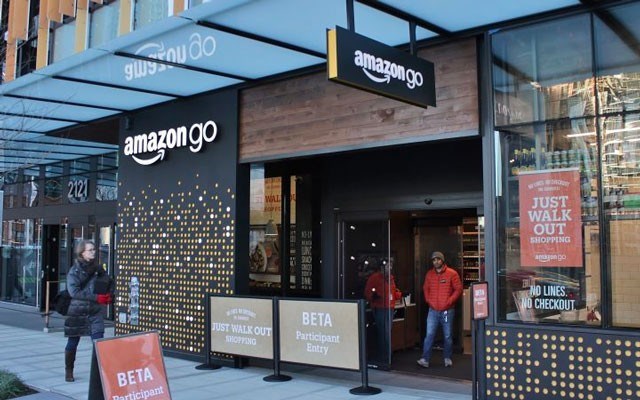It sounds like a dream world you'd cook up when you were a kid and never imagined could come true: A store where you walk in, grab what you want and walk out.
Last week, Amazon made waves when it opened its cashierless Amazon Go store in Seattle. Sure, it was just a small convenience store of 1,600 square feet. But it captured imaginations as people grabbed a sandwich or quart of milk and sailed out between the waist-high scanners, without a security guy stopping them or, for that matter, a friendly smile from a cashier.
No check-outs. No line-ups. No reaching for wallets. All customers needed to do was scan in the Amazon Go app with their phones and register their payment cards before entering the store. AI (artificial intelligence) took care of the rest.
Overhead cameras throughout the store grab images of what you grab. If you change your mind and put back that bag of chips, no problem. The scanners only read what you carry out. You get an electronic receipt posted to your phone as soon as you walk through the scanners, and Bob's your uncle — you're back to real life.
Given Amazon bought Whole Foods last year for US$13.7 billion (cash), industry pundits are predicting it won't be long before we see cashierless Whole Foods, and more.
According to Statistics Canada, there were 317,000 cashiers across the country in 2016. So how might cashierless technology impact those friendly, smiling cashiers, many of whom are new arrivals or young people working their first jobs much as I was a hundred years ago?
My teenaged career aside, cashiering must be one of the biggest overlooked jobs on the planet, so I turned to somebody who knows lots about it for insight. Bruce Stewart is the 20-year manager of Nesters Market at Whistler, once named the best grocery store in Canada. At 15,000 square feet and stocking some 30,000 items, it's also the biggest store in Buy-Low Foods, which now owns 51 Nesters, Choices and Buy-Low stores.
Nesters at Whistler has about 25 cashiers. By far, the lion's share is 1. seasonal workers from places like Australia, the UK and Germany, and 2. high school kids, who work, maybe, one or two nights and a full day on weekends.
There's definitely a gender thing to cashiering — 95 per cent of cashiers at Nesters are women. That's also what I saw working as a cashier, and I wonder why.
"My personal opinion is that guys have a hard time staying in one spot. Boys tend to want to be moving around, just like kids in school these days," says Bruce. "Also, women tend not to like the more physical work — not that cashiering is not physical, by any means — but they tend to want that job more than being on the grocery floor."
Cashiering in a grocery store is hard work. You have to grab and scan 10-kilo bags of dog food or potatoes, you have to contend with a lot of repetitive motions, you have to stand on hard floors, and more. A WorkSafe BC report on cashier ergonomics lists top concerns as bagging wells being too low and check stands needing to be adjustable in height.
Nesters uses a lot of the modern fixes, like rubber mats for better back support and adjustable bag wells, along with an interesting concept: Their cashiers can face two different directions so they're not always using the same muscles. They can work from left to right for part of the day, then reverse it.
Interesting, too, that the AI Amazon Go is using isn't much of a stretch from current practices. Self-checkouts are commonplace, and when it comes to privacy issues, you already give up a lot of data every time you use your "points" card, wherever you shop. They tell managers like Bruce things like how often you shop and what you buy.
Stores like Nesters already scan bar codes and input data on each of those 30,000 products — product size and description, wholesale costs, retail prices and even the dates when things go on and off sale, so prices are adjusted automatically at the till and customers get charged the right amount.
As for AI eliminating cashier jobs, Bruce reckons it's a long shot. There's also good and bad to it. In a place like Whistler, where it's tough finding workers to fill jobs like cashiering, it could be a good thing. And for industry giants like Walmart, the cost of installing all that technology might make sense. But for a store like Nesters, where you have, say, 600 hours a week with cashiers paid about 15 bucks an hour, it just doesn't make financial sense.
"Besides, I would so struggle with the idea of not having that interaction at my checkouts, which I think is vital to any retail business," says Bruce. "There's way more cashiers do besides ring your items through. Ideally, they're the last points of reference for customers — the last customer service they get as they leave the store."
Brie Fitzgerald agrees. Originally from Brisbane, she's been a cashier at The Grocery Store in Whistler Village for about a year.
"The thing people love about Whistler is customer service, and (Amazon Go's approach) has cut it all out. We get asked everything! It's almost like we're a visitors' centre — where to eat dinner, what's going on around the place, everything."
You have to admit, it would be tough to find a piece of AI that can provide inside scoops like that.
Glenda Bartosh is an award-winning journalist who learned lots about people as a cashier.




